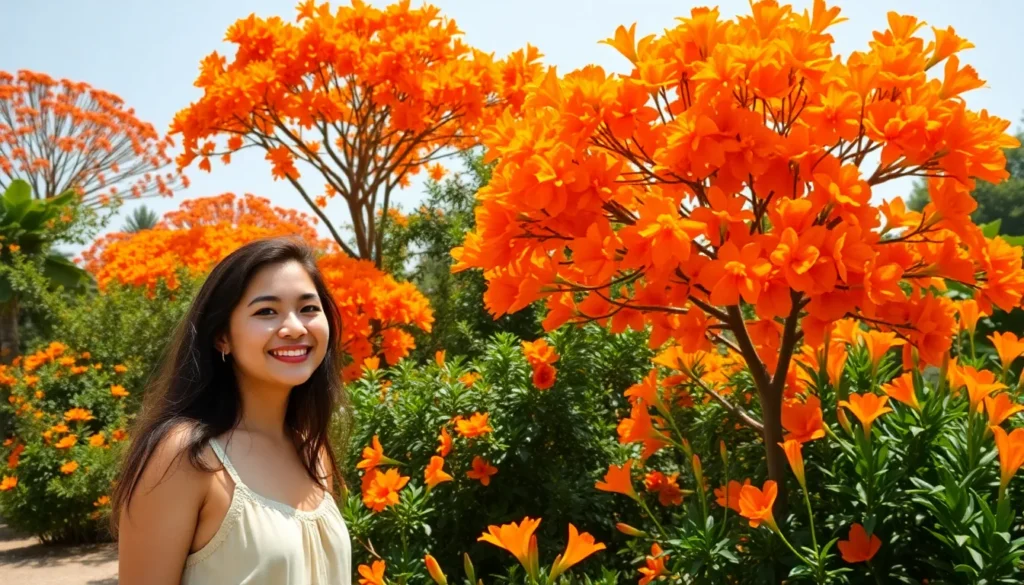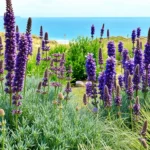Nothing transforms a industry quite like the vibrant burst of orange blossoms dancing in the breeze. We’ve all stopped in our tracks when encountering these stunning natural showstoppers – whether it’s the fiery crown of a flame tree or the delicate petals of an orange tulip tree creating a spectacular canopy overhead.
Orange flowering trees aren’t just beautiful additions to our gardens and neighborhoods; they’re powerful statement pieces that command attention year-round. From the tropical climates where African tulip trees thrive to temperate zones perfect for flowering quinces, these magnificent specimens offer us endless possibilities for creating breathtaking outdoor spaces.
We’re about to explore the most spectacular orange-bloomed trees that’ll revolutionize your industry design. You’ll discover which varieties flourish in your climate zone and learn the secrets to maximizing their stunning seasonal displays that neighbors will envy for years to come.
Best Orange Flowering Trees for Your Landscape
We’ve selected three outstanding orange flowering trees that’ll transform your outdoor space with their vibrant blooms and distinctive characteristics.
African Tulip Tree (Spathodea campanulata)
African tulip trees create stunning focal points with their brilliant orange red flowers that appear in large clusters from spring through fall. These fast growing trees reach heights of 40 to 60 feet and thrive in USDA zones 10 through 12.
Growing Requirements:
- Full sun exposure for optimal flowering
- Well draining soil with regular moisture
- Protection from strong winds due to brittle branches
- Minimum temperature tolerance of 50°F
We recommend planting African tulip trees as specimen plants where their spectacular blooms can be fully appreciated. Their flowers attract hummingbirds and butterflies while providing year round tropical appeal to southern gardens.
Flame Tree (Delonix regia)
Flame trees produce some of nature’s most dramatic displays with their fiery orange red blossoms that cover the entire canopy from May through July. These spreading trees grow 30 to 40 feet tall with an umbrella shaped crown that provides excellent shade.
Key Features:
- Feathery compound leaves create filtered shade
- Seed pods develop after flowering season
- Drought tolerant once established
- Suitable for zones 10 through 12
We suggest using flame trees in large landscapes where their 40 foot spread won’t overwhelm smaller properties. Their intense flowering period makes them perfect centerpiece trees for tropical and subtropical gardens.
Orange Trumpet Tree (Tabebuia aurea)
Orange trumpet trees offer reliable spring color with their golden orange tubular flowers that bloom before the leaves emerge. These medium sized trees reach 25 to 35 feet and adapt well to various soil conditions in zones 9 through 11.
Benefits for Landscaping:
- Compact size fits smaller properties
- Tolerates urban pollution and salt spray
- Deciduous nature provides seasonal interest
- Attracts native pollinators and wildlife
We find orange trumpet trees particularly valuable for their moderate size and consistent blooming habits. Their trumpet shaped flowers create striking displays against bare branches in early spring before most other trees begin leafing out.
Popular Orange Flowering Trees for Small Yards
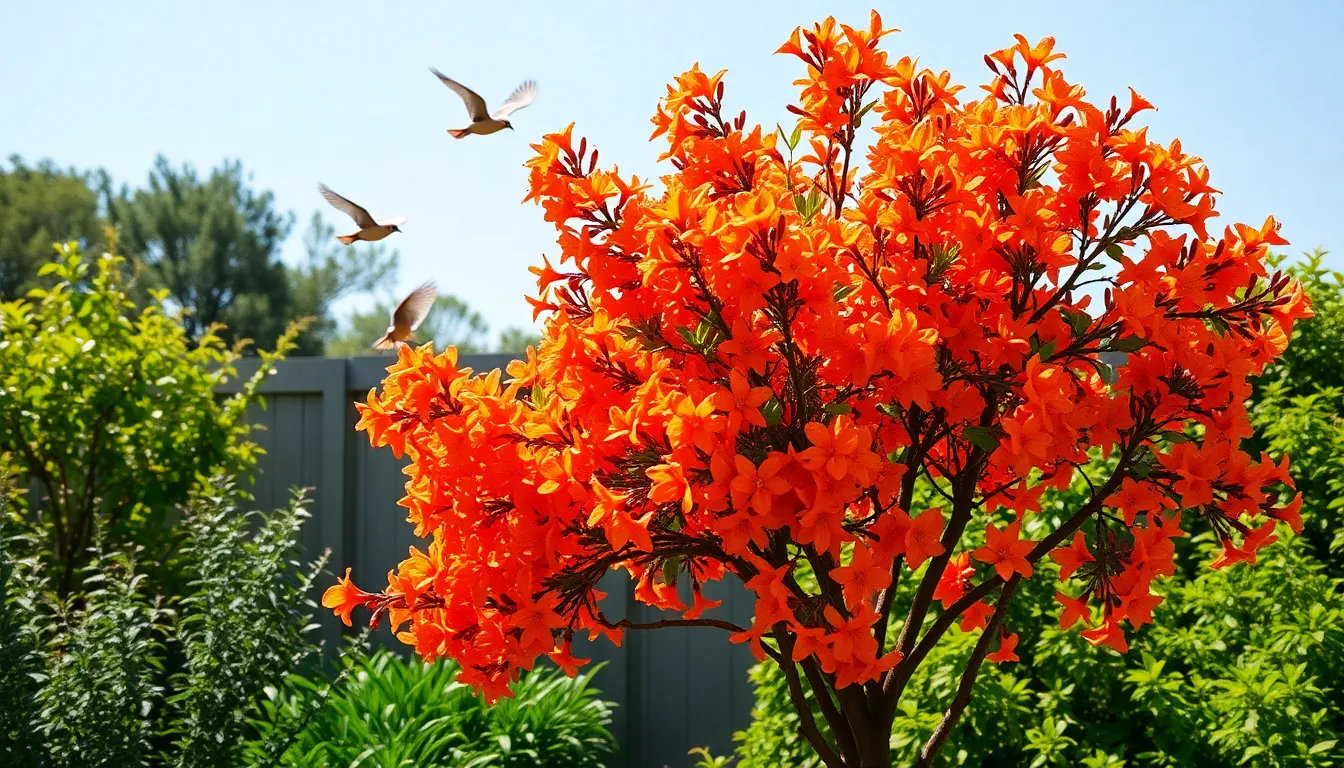
Small yard spaces deserve vibrant orange flowering trees that create stunning focal points without overwhelming your industry. We’ve carefully selected trees that deliver exceptional orange blooms while maintaining manageable sizes for compact gardens.
Cape Honeysuckle (Tecoma capensis)
Cape Honeysuckle stands out as our top recommendation for small yards seeking vibrant orange blooms throughout the summer months. This versatile shrub-like tree produces brilliant orange tubular flowers that attract hummingbirds and butterflies to your garden space. We love how it adapts to various growing conditions while maintaining a compact growth habit perfect for tight spaces.
Growing Requirements:
- USDA zones 9 to 11
- Full sun to partial shade
- Well-draining soil
- Regular watering during establishment
Jamaican Rain Tree (Brya ebenus)
Jamaican Rain Tree offers stunning orange blooms on a relatively small frame that works beautifully in compact landscapes. This unique specimen can reach up to 30 feet tall but maintains a narrow profile that won’t dominate your yard’s visual space. We recommend this tree for gardeners in warmer climates who want something truly distinctive.
Key Features:
- USDA zone 10
- Orange flowering display
- Drought tolerance once established
- Unique branching structure
Alternative Colorful Options
| Tree Species | Flower Color | USDA Zones | Mature Height |
|---|---|---|---|
| Prairifire Crabapple | Pink-red | 4-8 | 15-20 feet |
| Crape Myrtle | Various colors | 6-9 | 10-25 feet |
| Purpleleaf Sand Cherry | Pink-white | 3-8 | 6-10 feet |
While these alternatives don’t produce orange flowers specifically, they provide excellent color options for small yards where true orange flowering trees might not thrive in your climate zone. We suggest considering your exact USDA growing zone when selecting the perfect tree for your industry design goals.
Fast-Growing Orange Flowering Trees
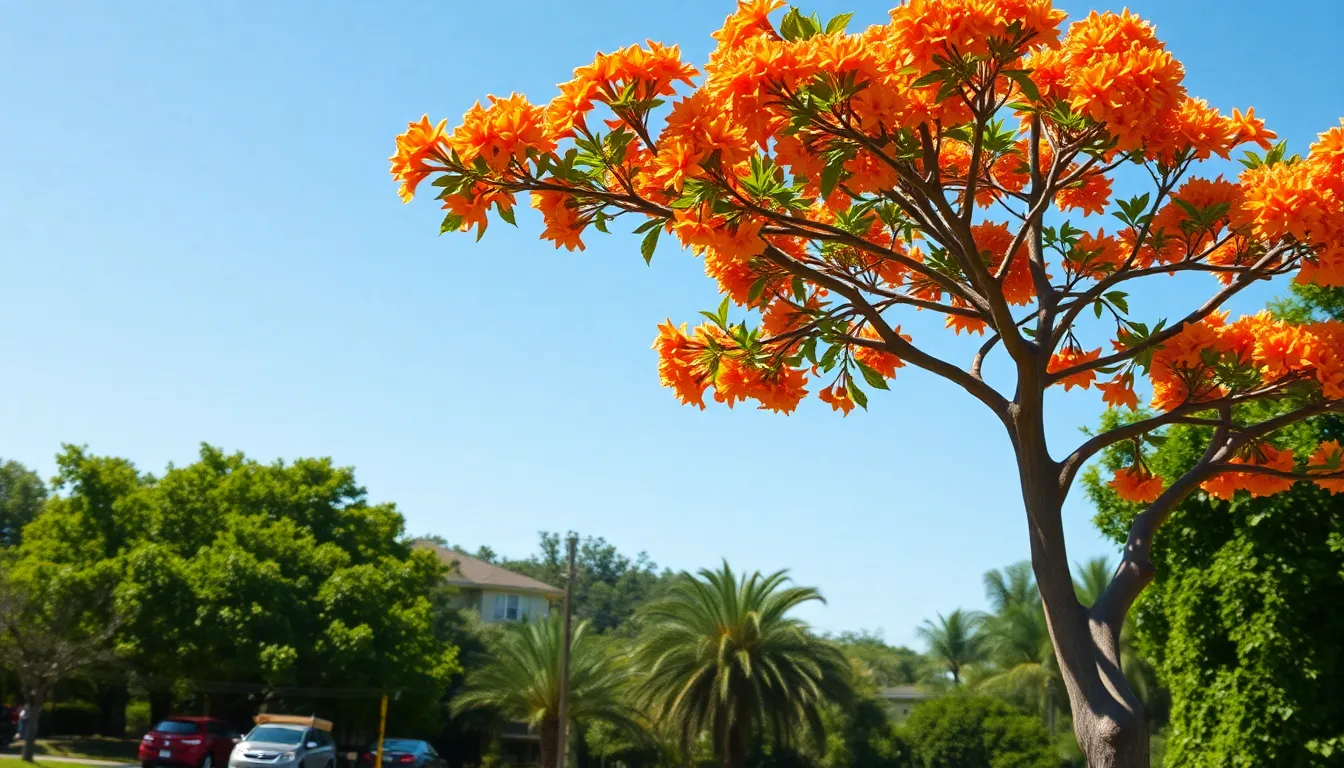
When you’re looking to establish vibrant orange blooms quickly in your industry, these fast-growing varieties deliver spectacular results within just a few seasons.
Royal Poinciana (Delonix regia)
Royal Poinciana stands out as one of the most magnificent fast-growing orange flowering trees for warmer climates. This large evergreen tree produces vibrant orange blooms that create a stunning canopy display throughout the summer months. Growing rapidly to heights of 30 to 40 feet tall, it’s perfect for creating dramatic focal points in spacious landscapes.
We recommend planting Royal Poinciana in USDA growing zones 9 to 11, where it thrives with minimal care requirements. Full sun exposure brings out the most intense orange coloration in its flowers, while the tree adapts to various soil types without being particularly demanding. Property owners with larger yards will appreciate how this tree’s umbrella-shaped crown provides excellent shade alongside its spectacular blooms.
Orange Bottlebrush (Callistemon citrinus)
Orange Bottlebrush offers a unique twist on orange flowering trees with its distinctive brush-like flower clusters. These fascinating blooms appear in vibrant orange or red shades, creating an eye-catching display from spring through summer. Growing up to 15 feet tall, this tree fits well in medium-sized landscapes where space might be more limited.
Successful cultivation requires well-drained soil and full sun exposure for optimal flowering performance. We’ve found that Orange Bottlebrush adapts well to various growing conditions while maintaining consistent bloom production. The tree’s compact size makes it an excellent choice for homeowners who want orange flowering impact without overwhelming their outdoor space.
Flame Azalea (Rhododendron calendulaceum)
Flame Azalea brings brilliant orange flowers to cooler climate gardens where other orange flowering trees might struggle. Spring blooms create a spectacular show of vibrant orange color that lights up the industry. Typically growing to 6 to 8 feet tall, this azalea works perfectly as an understory tree or focal point in smaller garden settings.
USDA growing zones 5 to 7 provide the ideal climate conditions for Flame Azalea to flourish and produce its stunning orange blooms. Acidic soil and partial shade create the perfect growing environment, making it suitable for woodland gardens or areas beneath larger trees. We recommend this variety for gardeners in northern regions who want to enjoy orange flowering trees even though cooler temperatures.
Cold-Hardy Orange Flowering Trees
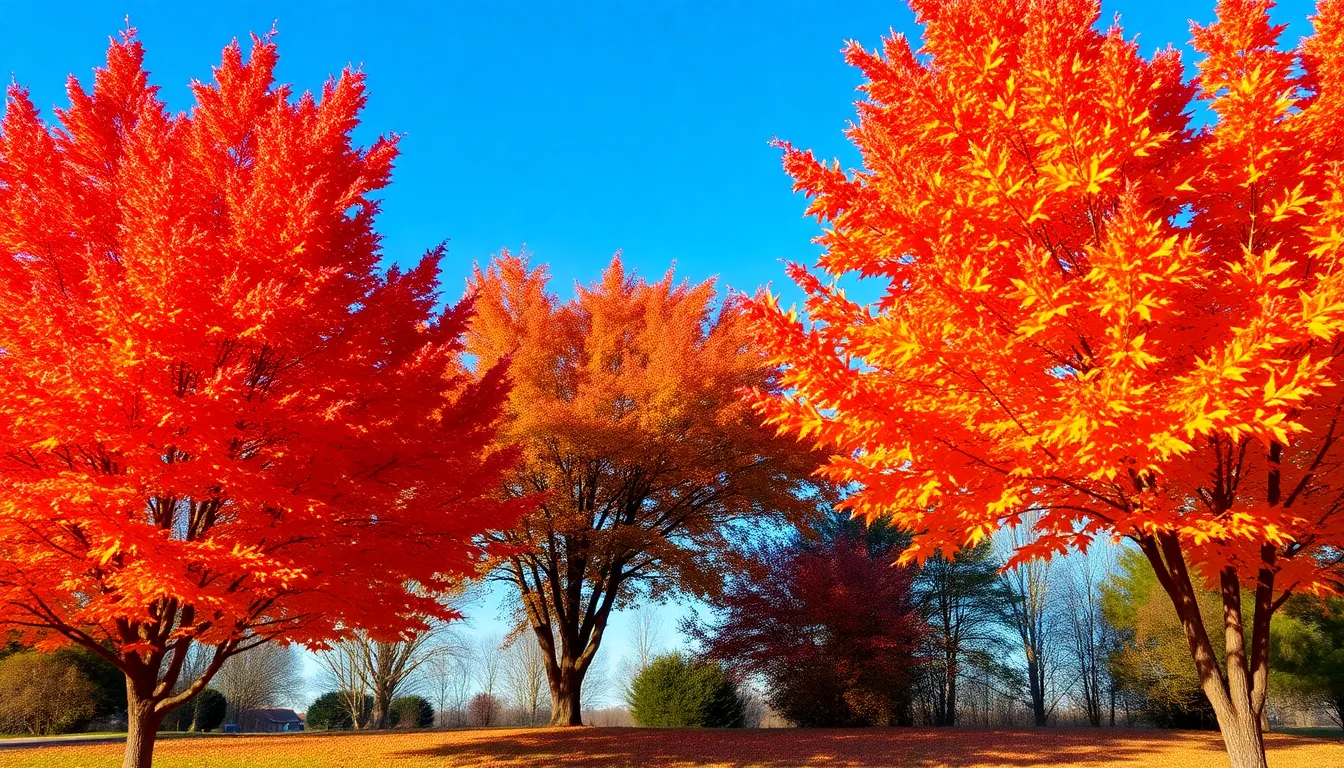
Finding orange flowering trees that withstand harsh winters presents unique challenges for northern gardeners. We’ve identified three exceptional cold hardy species that bring vibrant autumn color and reliable performance to landscapes in USDA zones 3 through 8.
Sugar Maple (Acer saccharum)
Sugar Maple stands as the quintessential cold weather champion, thriving in temperatures as low as -40°F across USDA zones 3 through 8. This magnificent deciduous tree reaches impressive heights of 60 to 75 feet, creating spectacular shade coverage for large properties. While its early spring flowers appear small and yellow green, the true orange spectacle emerges during fall when leaves transform into brilliant orange, red, and yellow displays.
Homeowners appreciate Sugar Maple’s dual purpose functionality, serving as both a stunning industry specimen and a source for maple syrup production. The tree’s exceptional cold tolerance makes it perfect for northeastern gardens where other orange flowering varieties simply can’t survive harsh winter conditions.
American Persimmon (Diospyros virginiana)
American Persimmon delivers reliable performance in USDA zones 4 through 9, surviving winter temperatures down to -25°F with remarkable resilience. This native deciduous tree grows 30 to 70 feet tall, producing small bell shaped cream to greenish flowers during late spring or early summer. The real orange attraction comes from its notable fall fruit, which provides both visual appeal and wildlife value.
Gardeners value American Persimmon for its edible fruit production and ornamental industry presence. The tree’s high cold hardiness rating makes it an excellent choice for regions where traditional orange flowering trees struggle to establish and thrive.
Serviceberry (Amelanchier canadensis)
Serviceberry, also known as Shadblow or Juneberry, thrives in USDA zones 4 through 8 while tolerating winter lows down to -30°F. This versatile small tree or large shrub reaches 15 to 25 feet tall, producing showy white flower clusters in early spring before leaves emerge. The orange red fall foliage creates stunning seasonal displays that rival any traditional orange flowering variety.
We recommend Serviceberry for its triple value combination of ornamental beauty, edible berry production, and wildlife food source benefits. The tree’s compact size and exceptional cold tolerance make it perfect for smaller northern properties seeking reliable orange autumn color.
Tropical Orange Flowering Trees
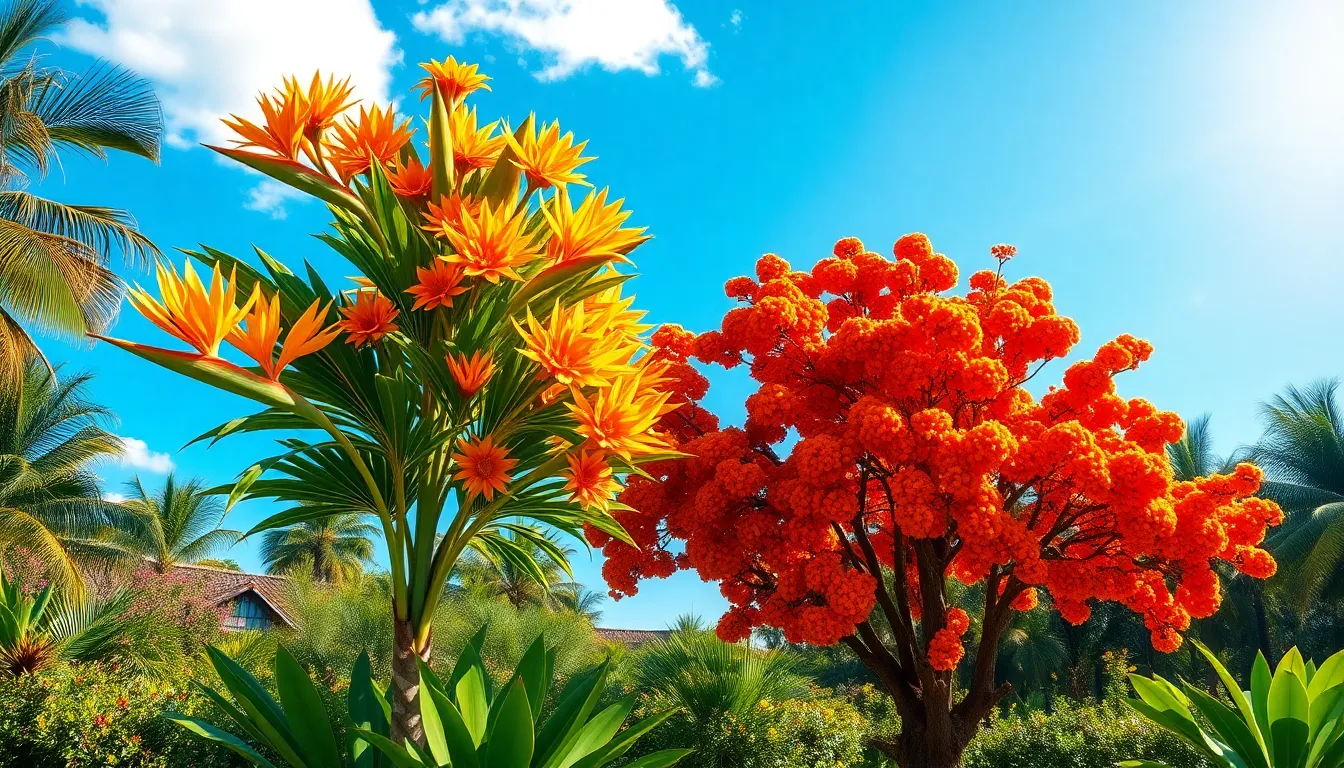
We’re now exploring the magnificent tropical species that thrive in warm climates and deliver spectacular orange blooms year-round. These heat-loving trees transform landscapes with their vibrant displays and exotic appeal.
Bird of Paradise Tree (Caesalpinia gilliesii)
Bird of Paradise Trees captivate gardeners with their exotic flowers that resemble colorful bird heads complete with dramatic beaks. While these striking blooms feature predominantly yellow petals, they’re beautifully accented with vibrant red and orange highlights that create stunning visual impact. Native to South America, this species adapts well to USDA zones 8 through 11 and tolerates drought conditions once established. Growing to heights of 6 to 10 feet, it works perfectly as a specimen plant or hedge in tropical landscapes. Butterflies and hummingbirds flock to these unique flowers, making them excellent choices for wildlife gardens.
Coral Tree (Erythrina species)
Coral Trees produce some of the most brilliant orange flower displays in the tropical tree industry. Erythrina lysistemon stands out as a particularly stunning species, creating dense clusters of deep orange to red-orange blooms that cover the entire canopy. These deciduous trees typically reach 20 to 30 feet in height and spread equally wide, making them ideal statement pieces for larger tropical properties. Flowering occurs before leaf emergence in late winter or early spring, creating an absolutely breathtaking spectacle against bare branches. Fast growth rates and tolerance for various soil types make coral trees popular choices throughout USDA zones 9 to 11.
Flamboyant Tree (Delonix regia)
Flamboyant Trees earn their dramatic name through spectacular displays of bright orange summer blooms that transform entire landscapes. Also known as royal poinciana, this large evergreen species creates umbrella-shaped canopies that can spread 30 to 40 feet wide at maturity. Orange flowers appear in dense clusters from May through August, providing months of continuous color in tropical gardens. Mature specimens can reach heights of 30 to 40 feet, making them perfect shade trees for parks, large properties, and commercial landscapes. These trees thrive in USDA zones 10 through 12 and prefer well-draining soil with regular watering during establishment periods.
Low-Maintenance Orange Flowering Trees
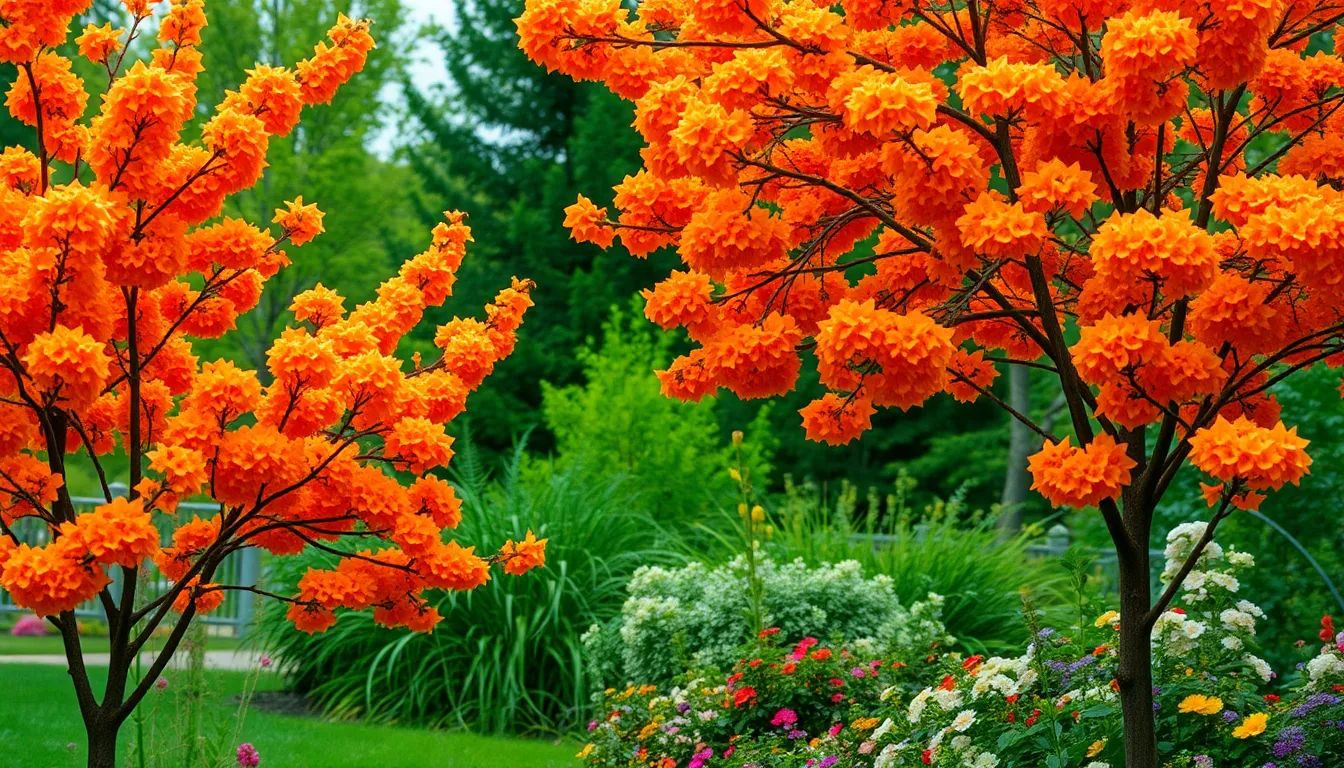
When you’re seeking gorgeous flowering trees that won’t demand constant attention, several remarkable species offer stunning blooms with minimal care requirements. We’ve selected three exceptional varieties that combine beautiful flowers with easy maintenance for busy gardeners.
Eastern Redbud (Cercis canadensis)
Eastern redbuds deliver spectacular spring displays with their distinctive heart shaped leaves and vibrant flower clusters that appear before the foliage emerges. These deciduous trees typically showcase pink or purple blooms rather than true orange flowers, though some cultivars produce pinkish orange tints in certain lighting conditions. We recommend this species for gardeners in USDA zones 4 through 9 who want a relatively low maintenance option that tolerates various soil types.
Growing 20 to 30 feet tall, eastern redbuds adapt well to both full sun and partial shade locations while requiring minimal pruning or fertilization. Their drought tolerance once established makes them ideal for gardeners who prefer hands off tree care. Native to eastern North America, these trees support local wildlife including butterflies and early season pollinators seeking nectar sources.
Flowering Crab Apple (Malus species)
Flowering crab apples offer exceptional spring beauty with their abundant flower displays that range from white to pink, with select varieties producing subtle orange tinged blooms. These versatile trees combine showy spring flowers with colorful fall fruit that attracts birds and adds seasonal interest to your industry. We particularly value their low to moderate maintenance requirements and adaptability to various growing conditions.
Most flowering crab apple varieties reach 15 to 25 feet in height and width, making them suitable for medium sized properties in USDA zones 4 through 8. Their tolerance for urban pollution, salt spray, and diverse soil conditions makes them excellent choices for challenging growing sites. Disease resistant cultivars like ‘Prairifire’ and ‘Royal Raindrops’ require minimal intervention while providing years of reliable blooms.
Orange Jessamine (Murraya paniculata)
Orange jessamine produces clusters of small, star shaped flowers that fill the air with intense fragrance throughout much of the year. While the blooms are predominantly white rather than orange even though the common name, this evergreen tree offers continuous low maintenance beauty in warm climate gardens. We recommend this species for gardeners in USDA zones 9 through 11 who want a compact flowering tree with minimal care requirements.
Reaching 8 to 12 feet in height, orange jessamine thrives in both full sun and partial shade with regular watering during establishment. Once mature, these trees tolerate brief dry periods and require only occasional pruning to maintain their naturally rounded shape. Their dense foliage and fragrant flowers make them excellent choices for privacy screens, foundation plantings, or small accent trees in tropical and subtropical landscapes.
Orange Flowering Trees That Attract Wildlife
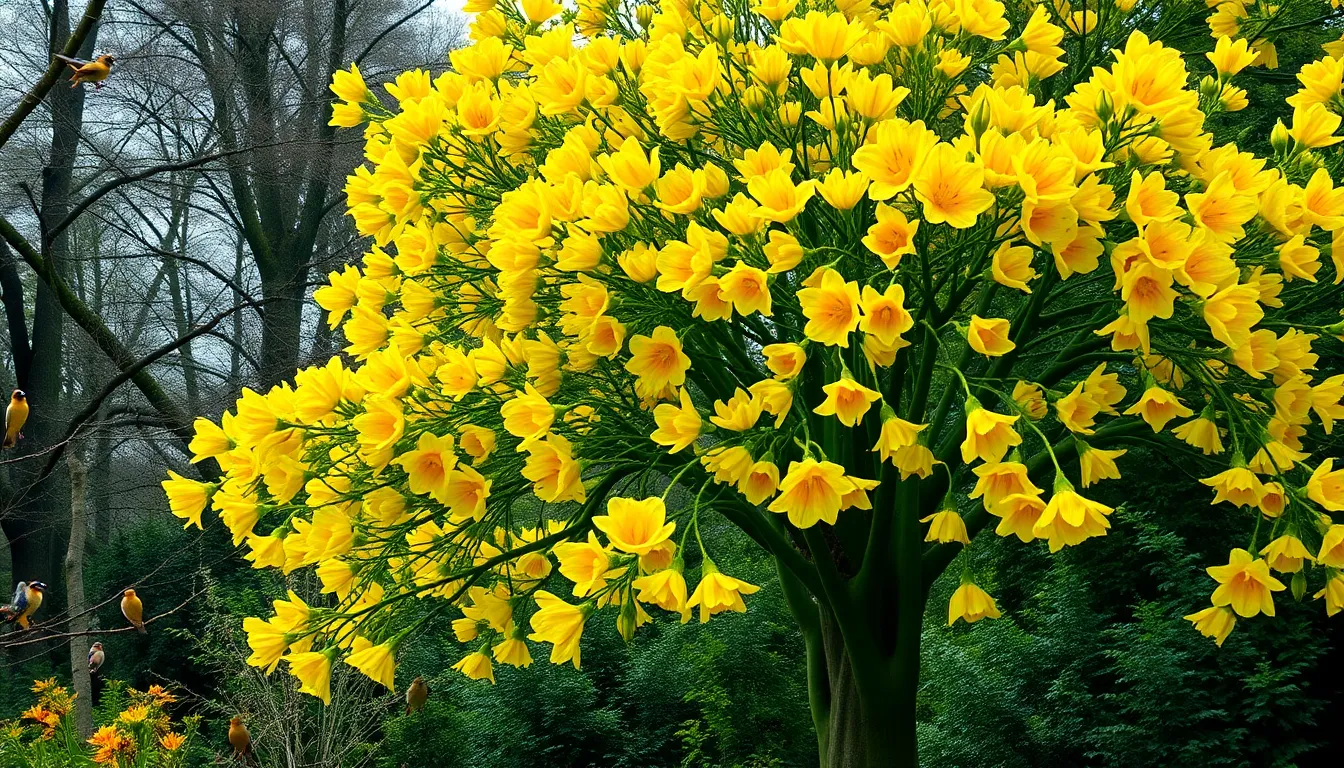
Beyond their stunning visual appeal, orange flowering trees serve as vital wildlife magnets that transform your garden into a thriving network. These remarkable species create feeding stations and habitat zones that support various birds, pollinators, and beneficial insects throughout the growing season.
Tulip Tree (Liriodendron tulipifera)
Tulip trees produce distinctive greenish-yellow flowers with vibrant orange patterns that create an irresistible beacon for pollinators. These towering natives reach heights of 70 to 90 feet and develop tulip-shaped blooms in late spring that attract bees, butterflies, and other beneficial insects seeking nectar. We’ve observed that mature tulip trees become essential feeding stations for ruby-throated hummingbirds during their migration periods.
The tree’s large, uniquely shaped leaves provide nesting sites for various songbird species throughout the summer months. During autumn, tulip trees offer additional wildlife value as their seeds feed squirrels, chipmunks, and many bird species including cardinals and finches. Gardeners in USDA zones 4 through 9 can establish these magnificent specimens as long-term wildlife habitats that support local ecosystems for decades.
Black Cherry (Prunus serotina)
Black cherry trees burst with clusters of fragrant white flowers in spring that serve as critical early-season nectar sources for emerging pollinators. These native beauties grow 50 to 80 feet tall and produce small, dark cherries that become wildlife magnets from midsummer through early fall. We’ve documented over 200 bird species that rely on black cherry fruit, including robins, cedar waxwings, and various thrush species.
Deer frequently browse the foliage and twigs, while black bears seek out the nutrient-rich cherries in woodland settings. The tree’s bark provides shelter for beneficial insects during winter months, creating year-round habitat value. Butterfly enthusiasts particularly appreciate black cherry trees since they serve as host plants for eastern tiger swallowtails and cherry scallop shell moths.
Orange Hawkweed Tree (Hieracium aurantiacum)
Orange hawkweed displays brilliant orange flower heads that function as specialized pollinator magnets throughout the growing season. This compact perennial reaches only 1 to 2 feet in height but produces multiple flower clusters that attract native bees, butterflies, and beneficial wasps. We’ve noted that orange hawkweed flowers provide essential nectar sources during mid to late summer when many other blooms have faded.
The plant’s low-growing rosette of leaves creates ground-level shelter for small beneficial insects and spiders that help control garden pests. Goldfinches and other seed-eating birds harvest the mature flower heads during autumn, extending the plant’s wildlife value beyond the blooming period. Gardeners can establish orange hawkweed in USDA zones 3 through 9 as naturalized plantings that support local pollinator populations with minimal maintenance requirements.
Best Planting Tips for Orange Flowering Trees
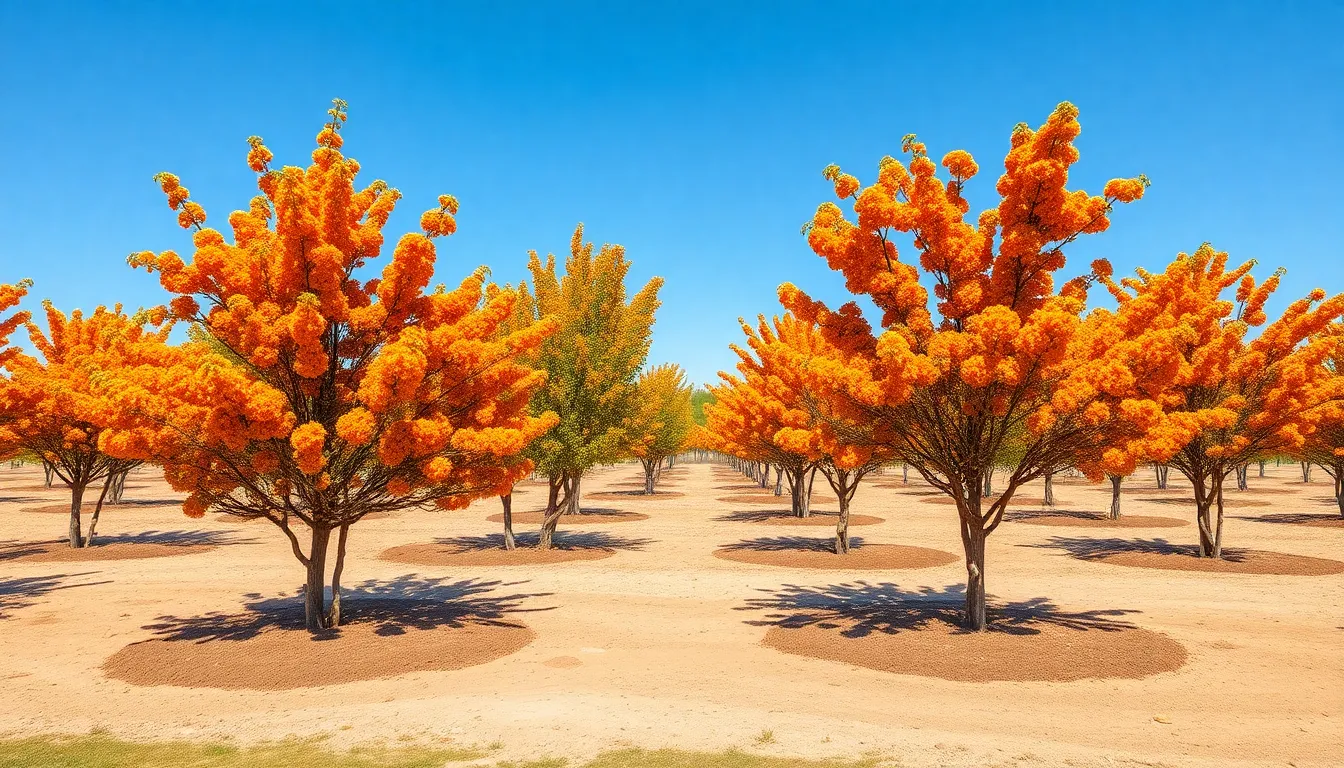
We’ll help you establish stunning orange flowering trees in your industry with proven planting techniques. Success starts with understanding your exact tree’s needs and creating optimal growing conditions.
Soil Requirements and Preparation
Well-drained soils provide the foundation for healthy orange flowering trees. Sandy loams and regular loams work best because they prevent waterlogging around roots, which can cause serious health problems.
Testing your soil pH ensures proper nutrient uptake for vibrant blooms. Aim for a pH between 6.0 and 7.5 to maintain that slightly acidic to neutral range most orange flowering trees prefer. Highly acidic or alkaline conditions often lead to nutrient deficiencies and yellowing leaves.
Preparing your planting hole properly sets your tree up for success. Dig a hole that’s twice as wide and as deep as the root ball to give roots room to establish. Adding compost or sand improves drainage in poorly draining soils, creating the ideal growing environment.
Optimal Planting Seasons
Spring and fall offer the best windows for planting orange flowering trees in temperate climates. These seasons allow trees to establish strong root systems before facing extreme summer heat or winter cold.
Spring planting works especially well because trees have the entire growing season to develop. Fall planting can be equally successful since cooler temperatures reduce transplant stress while soil remains warm enough for root growth.
Avoiding extreme weather periods protects newly planted trees from unnecessary stress. Summer’s intense heat and winter’s freezing temperatures make establishment much more challenging for young orange flowering specimens.
Spacing and Location Considerations
Full sun exposure remains critical for abundant orange blooms on most flowering trees. Plan for at least 6 to 10 hours of direct sunlight daily to ensure maximum flower production and tree health.
Proper spacing prevents overcrowding as trees mature. Plant orange flowering trees 20 to 30 feet apart for most varieties to allow adequate room for their full canopy development.
Good air circulation reduces disease pressure and promotes healthy growth patterns. Choose locations away from buildings, fences, or other trees that might restrict airflow around your orange flowering specimens.
Root crown placement determines long-term tree stability and health. Position the root crown level with the soil surface when backfilling your planting hole, then press soil gently around roots to eliminate air pockets that could cause settling problems.
Care and Maintenance of Orange Flowering Trees
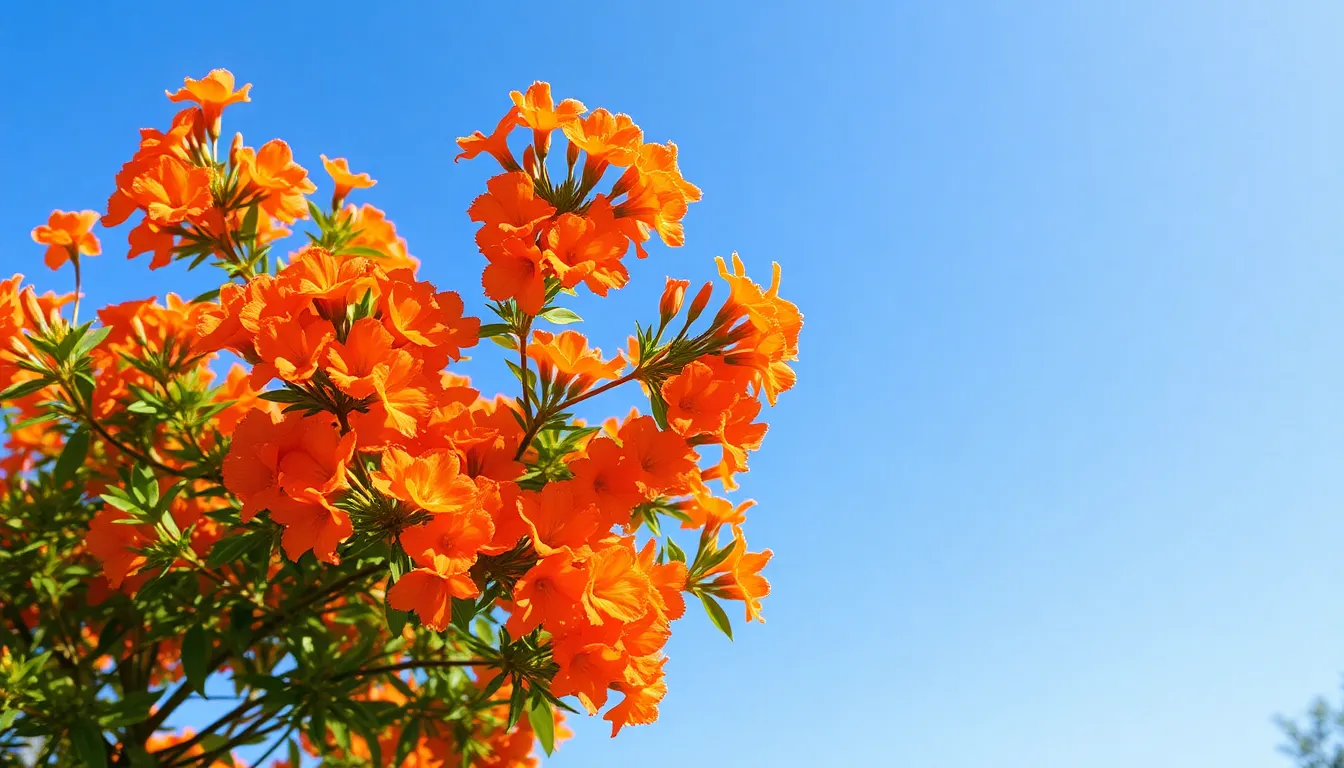
Proper care ensures your orange flowering trees develop healthy root systems and produce spectacular seasonal displays. Consistent maintenance practices help these vibrant specimens thrive in various climate conditions.
Watering Requirements
Consistent moisture without waterlogged conditions keeps orange flowering trees healthy and blooming. We recommend providing approximately 1 inch of water weekly for established trees, adjusting based on natural rainfall patterns. Deep watering sessions encourage strong root development rather than frequent shallow applications.
Well draining soil prevents root rot and other moisture related diseases that commonly affect flowering trees. Sandy loams and regular loams work best for most orange blooming species, allowing excess water to move through the soil profile. Avoid overwatering during dormant seasons when trees require less moisture.
Monitor soil moisture levels by checking 2 to 3 inches below the surface before watering. Newly planted trees need more frequent attention during their first growing season to establish robust root systems.
Pruning Techniques
Early spring pruning just before blossoms appear maximizes flowering potential for most orange blooming trees. We suggest removing diseased, damaged, or crossing branches to improve air circulation and prevent pest problems. Clean, sharp pruning tools minimize wound damage and reduce infection risks.
Post bloom pruning works better for trees that flower on old wood, encouraging new growth for next season’s display. Remove sparsely leafed branches and water sprouts that compete for nutrients with flowering wood. Shape your trees gradually over several seasons rather than making drastic cuts.
Timing varies by species, so research your exact tree’s blooming habits before scheduling major pruning sessions. Light maintenance pruning can occur throughout the growing season to remove dead flowers and maintain desired shapes.
Fertilization Schedule
Three applications per year provide optimal nutrition for most orange flowering trees without overstimulating vegetative growth. We recommend fertilizing in early spring before bud break, mid summer during active growth, and early fall to prepare for dormancy. Balanced fertilizers with equal nitrogen, phosphorus, and potassium ratios work well for general feeding.
Soil testing reveals exact nutrient deficiencies that might affect flowering performance and overall tree health. Slightly acidic to neutral pH levels between 6.0 and 7.0 optimize nutrient uptake for most orange blooming species. Organic compost applications improve soil structure while providing slow release nutrients.
Avoid late season nitrogen applications that encourage tender growth susceptible to frost damage. Young trees benefit from more frequent, lighter feedings during their establishment period compared to mature specimens.
Common Problems with Orange Flowering Trees
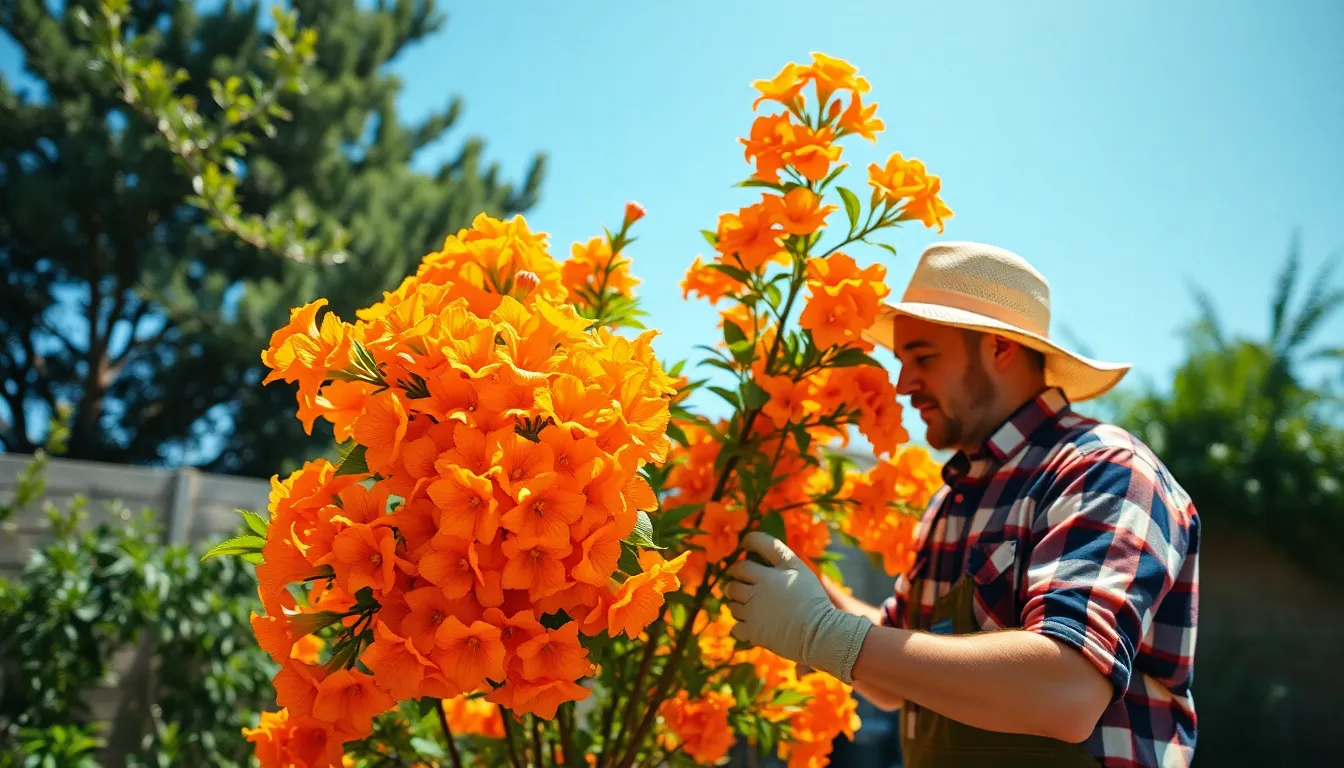
Even the most stunning orange flowering trees can face challenges that affect their health and spectacular blooms. Understanding these common issues helps us maintain vibrant displays throughout the growing season.
Disease Prevention
Maintaining optimal soil conditions forms the foundation of disease prevention for our orange flowering trees. We need to ensure adequate water and air drainage while using well-draining soils with proper pH levels to prevent root rot and fungal infections.
Balanced fertilization plays a crucial role in keeping our trees healthy and resistant to diseases like citrus canker and greasy spot. Regular soil testing allows us to adjust nutrient levels and maintain the fertility our orange flowering trees need to thrive.
Monitoring our trees regularly for early signs of disease helps us catch problems before they become severe. Common issues include citrus canker, which creates necrotic lesions on leaves, stems, and fruit, and greasy spot, a fungal infection that leads to leaf drop and reduced vigor.
Pest Management
Regular inspection of our orange flowering trees helps us identify pest problems before they cause important damage. We should check for signs of insects, mites, and other pests at least once a week during the growing season.
Proper spraying techniques ensure effective pest control without harming our trees or beneficial insects. Avoiding applications during hot, dry, or windy conditions protects both the treatment effectiveness and tree health.
Integrated pest management approaches work best for our orange flowering trees, combining biological controls with targeted treatments when necessary. This method maintains the natural balance while protecting our trees from harmful pests.
Environmental Stress Answers
Adequate sunlight exposure ensures our orange flowering trees produce abundant blooms and maintain healthy growth. Most varieties require at least 6 to 8 hours of direct sunlight daily for optimal performance.
Proper watering practices prevent both drought stress and waterlogged conditions that lead to fruit drop and root problems. We should provide consistent moisture while ensuring good drainage to avoid overwatering issues.
| Environmental Factor | Solution | Expected Outcome |
|---|---|---|
| Insufficient sunlight | Relocate or prune surrounding plants | Improved flowering and growth |
| Poor drainage | Amend soil or install drainage systems | Reduced root rot and fruit drop |
| Temperature stress | Provide wind protection and mulching | Better cold tolerance and stability |
Regular pruning and maintenance keep our orange flowering trees in peak condition throughout the seasons. Removing dead or diseased branches improves air circulation and reduces the risk of pest infestations and fungal problems.
Conclusion
Orange flowering trees offer an incredible opportunity to transform any industry into a vibrant showcase of natural beauty. Whether you’re working with a compact urban space or sprawling estate we’ve shown you there’s a perfect orange-bloomed variety for your exact needs and climate zone.
From the dramatic Royal Poinciana in tropical regions to the hardy Sugar Maple in northern climates these trees deliver stunning seasonal displays while providing valuable wildlife habitat. The key to success lies in matching each tree’s requirements with your garden’s conditions and following proper planting and care techniques.
With the right selection and maintenance approach you’ll enjoy years of spectacular orange blooms that enhance your property’s value and create an outdoor space that truly stands out in your neighborhood.
Frequently Asked Questions
What are the best orange flowering trees for small yards?
Cape Honeysuckle (Tecoma capensis) and Jamaican Rain Tree (Brya ebenus) are excellent choices for small spaces. Cape Honeysuckle produces brilliant orange tubular flowers and adapts well to various conditions in USDA zones 9-11. The Jamaican Rain Tree offers stunning orange blooms with a narrow profile, perfect for compact landscapes in warmer climates.
Which orange flowering trees grow the fastest?
Royal Poinciana (Delonix regia), Orange Bottlebrush (Callistemon citrinus), and Flame Azalea (Rhododendron calendulaceum) are top fast-growing options. Royal Poinciana creates magnificent canopies in zones 9-11, while Orange Bottlebrush offers unique brush-like flowers. Flame Azalea thrives in cooler climates (zones 5-7) and provides stunning blooms in shaded areas.
Can orange flowering trees survive in cold climates?
Yes, several orange flowering trees thrive in northern climates. Sugar Maple (Acer saccharum), American Persimmon (Diospyros virginiana), and Serviceberry (Amelanchier canadensis) all survive in USDA zones 3-8. These cold-hardy species provide beautiful orange fall colors and additional benefits like edible fruit or maple syrup production.
What orange flowering trees require the least maintenance?
Eastern Redbud (Cercis canadensis), Flowering Crab Apple (Malus species), and Orange Jessamine (Murraya paniculata) are low-maintenance options. Eastern Redbud adapts to various soil types in zones 4-9, while Flowering Crab Apple offers abundant blooms in zones 4-8. Orange Jessamine provides fragrant flowers with minimal care in zones 9-11.
Which orange flowering trees attract wildlife?
Tulip Tree (Liriodendron tulipifera), Black Cherry (Prunus serotina), and Orange Hawkweed Tree (Hieracium aurantiacum) excel at attracting wildlife. These trees provide nectar for pollinators, nesting sites for birds, and shelter for beneficial insects, transforming gardens into thriving ecosystems while offering beautiful orange blooms throughout the growing season.
When is the best time to plant orange flowering trees?
Spring and fall are optimal planting seasons for most orange flowering trees in temperate climates. Spring planting allows trees to establish before summer heat, while fall planting takes advantage of cooler temperatures and natural rainfall. Avoid planting during extreme weather conditions or when the ground is frozen or waterlogged.
How often should I water orange flowering trees?
Orange flowering trees typically need about 1 inch of water weekly, including rainfall. Water deeply but less frequently to encourage deep root growth. Avoid waterlogged conditions, which can lead to root rot. Newly planted trees may require more frequent watering until established, usually within the first year.
What type of soil do orange flowering trees prefer?
Most orange flowering trees thrive in well-drained sandy loams or regular loams. Proper drainage is crucial to prevent root rot and other moisture-related problems. Test soil pH to ensure optimal nutrient uptake, as different species may prefer slightly acidic to neutral soil conditions for best flowering performance.
How do I prevent diseases in orange flowering trees?
Maintain optimal soil conditions, provide balanced fertilization, and ensure proper spacing for air circulation. Regular inspections help identify problems early. Avoid overhead watering to reduce fungal diseases, and remove fallen leaves and debris. Proper pruning techniques also promote healthy growth and reduce disease susceptibility.
When should I prune orange flowering trees?
Timing depends on the flowering habit. For trees that bloom on new wood, prune in early spring before bud break to maximize flowering potential. For trees that flower on old wood, prune immediately after blooming to avoid removing next year’s flower buds. Remove dead, damaged, or crossing branches year-round.

